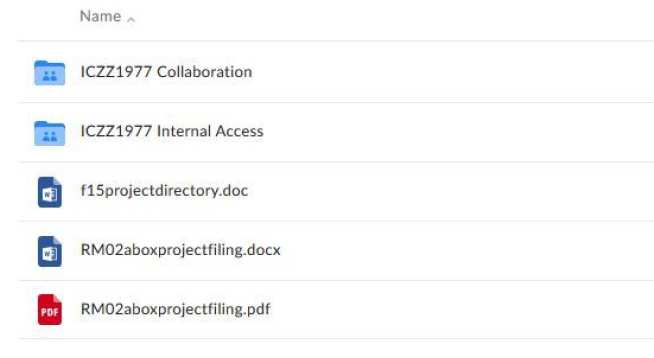Accessing and identifying digital information is reliant on good file naming practice. Increased use of cloud storage makes this even more essential to ensure files can be accessed across different platforms.
In summary:
- keep files short but meaningful
- use easily identifiable file names
- avoid repetition and redundant characters in file paths
- numbers should include at least two digits (01, 02 etc and not 1,2,3)
A well named file should be:
- Descriptive – it says what the document is about;
- Helpful – it distinguishes the document from others of a similar topic;
- Consistent – it follows standard convention;
- Concise – file names should not be too long.
Easily Identifiable file names
File names should be unique, easily identifiable and consistent. If a file is viewed out of context from its folder location it should be easy to understand what it relates to. For example, 2019-12-12Minutes doesn’t give any clues on the subject and there may be many other files for minutes for a multitude of topics. Whereas 2019-12-04BLKT1901TAGMinutes identifies that it was for project BLKT1901 and was for the TAG meeting.
Project related files must include the project number in the title. Do not insert a space between the building code and number. Ie CAGB1601 not CAGB 1601
Eliminate redundant words and characters
Make your file names as short as they can be whilst still making sense to others.
- Remove connecting words such as "and" or "the" which add length to the name but are not essential to understand the content.
- Avoid unnecessary spaces.
- Avoid word repetition (such as multiple use of "re" or "fwd" in an email)
- If using a dash “-“ it does not need a space either side in a file name.
- Use abbreviations where easily understood but avoid codes, acronyms or abbreviations that are not widely known.
Reduce Sub-folders
Every subfolder created adds to the file path of the file name. If a file path exceeds 260 characters for example, files could be inaccessible or corrupted when trying to access via Windows systems.
Select Properties when right-clicking a file and next to Location you will find the file path. Example: X:\Made up name\This folder\That folder\Templates contains 50 characters. Add the number of characters in your file name, including spaces, and that is the total length of the file path.
Avoid multiple nested sub-folders and repetition in their titles. Is another sub-folder needed if content is easily identified from the file names?
Extracting content from a zipped file can create an extra sub-folder - avoid this by selecting browse to unzip the content exactly where it is needed.
However, when using Box cloud storage, folder titles must be clearly understood when giving collaboration access, as they won’t see the nested files above to make sense of its context. Keep folder names short but meaningful, to reduce the file path whilst ensuring the folder's content is easily understood.
Problematic non-alphanumeric characters.
Operating systems and cloud storage systems may have different file naming requirements. Use of some non-alpha numeric characters could result in the file being automatically renamed when accessed via another system or becoming inaccessible or corrupted. Examples of characters to be avoided include:
- < (less than)
- > (greater than)
- : (colon)
- " (double quote)
- / (forward slash)
- \ (backslash)
- | (vertical bar or pipe)
- ? (question mark)
- ! (exclamation mark)
- £ (pound sign)
- * (asterisk)
The full stop symbol ( . ) should be used with caution and particularly not to be used at the end of a file name, as it can be confused with the file extension. The underscore symbol ( _ ) also should be avoided for documents used on the web.
Using numbers in file names
To arrange files in numeric order, include the zero for numbers 0-9 (or 00 if the sequence is likely to be over 100). For example: 01, 02, 03 .... or 001, 002, 010, 020, 021, 022 etc, depending on how long the sequence is likely to be.
Dates and times should always follow the BS ISO 8601:2004 basic format of YYYY-MM-DD. For example, 21st January 2019 would be written as 2019-01-21. The files can now be viewed in chronological order, facilitating access to the latest record.
Version control
Consistent version control helps everyone know which copy of a document they should refer to, provides an audit trail and reduces confusion over which is the current version. Inclusion of the version number and date within the footer of the document is good practice. Decimal increments should be used to distinguish between major and minor changes, with the inclusion of “draft” or “file” at the end of a file name if required. For example:
- first draft may be v0.1draft, followed by v0.2 draft;
- final version would then be v1.0;
- a minor update to this final version would be v1.1;
- a major update moves to the next revision number v2.0.
Correspondence files and emails
Think about how you title an email as long titles or inappropriate characters may cause an issue when files. If you are manually renaming emails for filing, inclusion of the following elements is recommended:
- Name of correspondent (surname and initial);
- Subject description (keeping it brief);
- date of correspondence (and time where necessary);
- type of correspondence (“re”, “fwd” etc).
Remove any surplus characters when saving correspondence from your email system. For example, multiple uses of “re” or “few”, unnecessary spacing or punctuation; and any unsuitable non-alphanumeric characters.
File naming for the web
An updated file must be named exactly the same as the existing version. This enables the new file to directly overwrite the original and maintain all hyperlinks to the document. Any change in version MUST be denoted in the footer of the document and can also be included in the descriptive text within the website media library.
For more advice on file naming for the web, contact either the Estates Records & Archives Officer or the Estates Communications Officer. Refer also to the College web guide pages for further guidance

